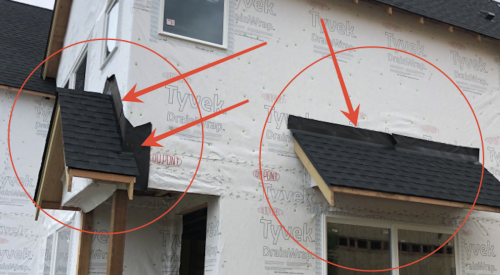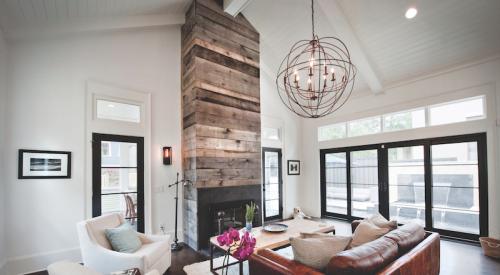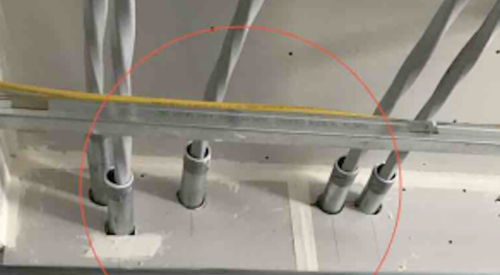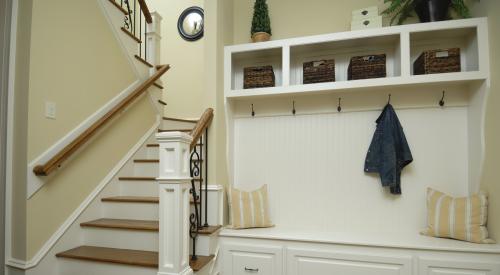 |
Builders must improve their understanding of and approach to sound transmission into the building and between dwelling units because of the potentially significant impact of noise on homeowner satisfaction...and the corporation's exposure to lawsuits.
In response to the potential for litigation and the impact of settlements or judgments on a builder's general liability insurance rates and coverage for acoustics, Giants who build multifamily housing are becoming more savvy and sophisticated about noise transmission.
"Avoiding a lawsuit is a major motivator," says John LoVerde, an associate principal with Veneklasen Associates, an acoustical consulting firm based in Santa Monica, Calif. "But builders also have gained experience in managing homebuyer expectations and understanding the acoustical limitations of building materials and systems," he says.
LoVerde says his Giant builder clients are involving acousticians earlier in the development process — as far back as land acquisition — as part of a comprehensive approach to acoustics in their multifamily projects.
Acoustical consultants and defendants' attorneys have joined forces to create legal and architectural formulas that builders can follow to improve acoustical performance in new and converted condominium projects. These formulas start with site selection and carry through after occupancy.
Site SelectionAn evaluation of the project's potential acoustical challenges begins with the site. Buildable land for multifamily projects is historically poor; the proposed site might be adjacent to an interstate, within earshot of an airport, or on an infill site within a busy urban core. "You need to think about the solutions for that site's conditions [such as exposure to aircraft noise] and budget for it," says LoVerde, as part of an overall financial proform a and the decision to purchase the parcel.
DesignDiligent acoustical assessments also play a part in the design process of the project's basic architectural elements and decisions. For instance, it is important to consider the stacking and alignment of units and the placement of non-sensitive areas (such as closets) against sensitive areas (like bedrooms) to reduce and buffer sound transmission.
Structural materials and systems, windows, exterior and interior finishes and mechanical systems all contribute to the building's Sound Transmission Class (STC) rating, a code-mandated standard. Some products, including doors (as both sound barriers and noise makers), tankless or on-demand water heaters, bathtubs and entry gates merit additional consideration for their acoustical contributions.
The good news is that, in almost every product category, systems and solutions for better acoustical performance are not only improved and more reliable, but also in greater variety can match specific conditions, finishes, and other design requirements.
LoVerde suggests builders set minimum standards that are higher than those required by current building codes to create a baseline of acoustical performance companywide, and then upgrade or adjust those standards to accommodate specific site conditions or other circumstances that could heighten the building's exposure to noise or the potential for sound transmission into and within the building.
In light of new construction defect laws, Sandra Stewart, a partner at a Los Angeles-based law firm, advises clients to not only engage acoustical consultants to help establish those standards, but also to document everything. Specifically, a paper trail of the code-compliant and approved plans and specifications for the project and specific provisions for addressing acoustical performance (among other hazards such as water intrusion), is essential.
InstallationGaining approvals for a multifamily project can be a daunting process — and the work can be all for naught if the execution in the field is substandard. "Builders often plan for good acoustical performance, but once all the trades come through, those barriers get breached," says Nader El-Hajj, a project manager at the NAHB Research Center in Upper Marlboro, MD, which conducts third-party testing on a variety of materials, including noise-abatement products.
In that regard, Stewart is most watchful of builders who are diversifying from detached housing into multifamily. Such builders, she says, are typically unfamiliar with floor-ceiling configurations that are more akin to commercial construction, and to supervising subcontractors to maintain sound-rated assemblies. Builders who are new to the condo realm, she says, must learn and apply a comprehensive approach to receiving, handling, combining, and applying materials and systems at the job site.
Both El-Hajj and LoVerde say that current code-approved assemblies for acoustical performance can be installed correctly in the field, as long as builders and subcontractors commit to paying attention to every detail. "We should be able to expect a qualified installer to do his job right," says LoVerde, who helps clients establish and follow protocols and procedures for each detail and its application in the field.
LoVerde also recommends integrating insight and ideas from subcontractors to deliver the best solution and ensure proper execution, as well as involving manufacturers to help educate the masses about proper handling and installation of their products. "There's got to be communication between us and the field and a willingness to leverage their ideas," says LoVerde.
An increasing number of suppliers are visiting job sites, he says, to interact with contractor installers to make sure their products are applied correctly...and get some feedback on how they might improve that process. "Manufacturers are doing a great job of refining their products and making them easier to apply," LoVerde says.
All of which adds up to a greater confidence among multifamily builders that their projects meet (and ideally far exceed) accepted acoustical standards, and are therefore less likely to prompt homeowner complaints and lawsuits.
Sales and Customer ServiceOne skill set Giants bring to the multifamily table is an acute awareness of what buyers want and expect, as well as how to manage those expectations and deliver exceptional customer service.
Today's multifamily buyers demand an experience that's closer to detached-home living than to apartment dwelling — in large part because of an increasing contingent of condo buyers moving down from detached homes, bringing with them expectations of quiet indoor living.
Logically, builders who have done the upfront work regarding acoustical performance will have an easier time articulating the value of that diligence and attention to detail to a potential buyer. They can establish reasonable expectations for inter-unit and environmental noise, the homeowner's role in maintaining those standards, and the procedures for addressing issues and complaints.
After the building is occupied, the builder's process for managing complaints — whether from individual owners or through the homeowner's association (HOA) — is a critical element to managing the risk of litigation and achieving a high level of customer satisfaction. "Early in the project strategy, make sure there are specific provisions regarding homeowner modifications and other instances that might alter acoustical performance," says Stewart, as well as those that defer complaint management to the HOA's authority. "It's a key piece of a comprehensive, integrated approach to this risk."
Giants that are developing multifamily housing, or considering it, can use that approach to not only build better housing from the ground up and through occupancy, but also manage their legal exposure, control their insurance rates, and achieve a higher level of customer satisfaction in the process.












